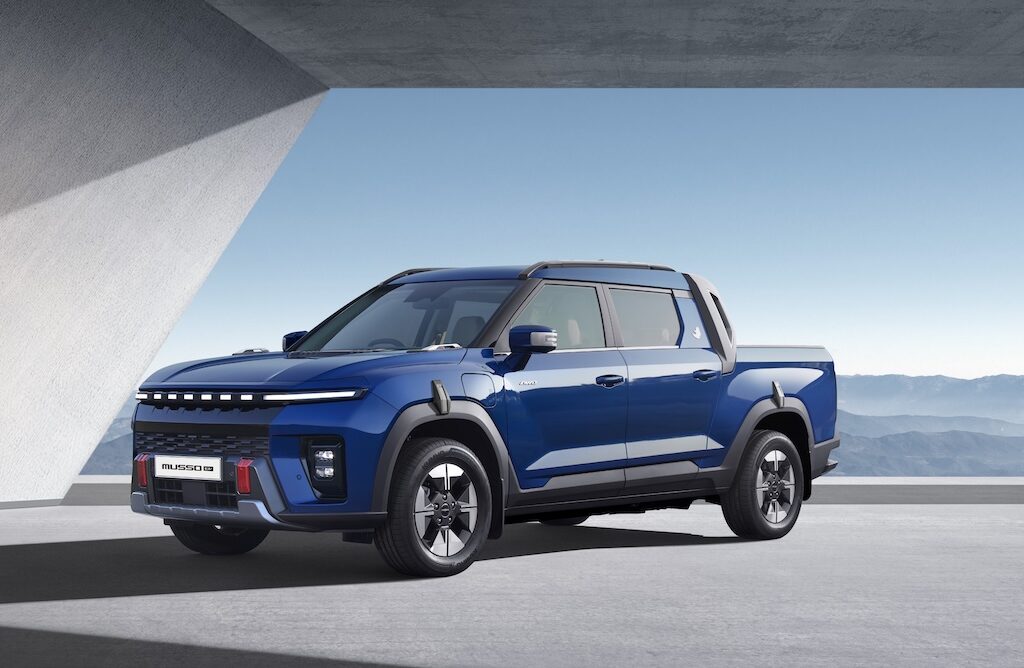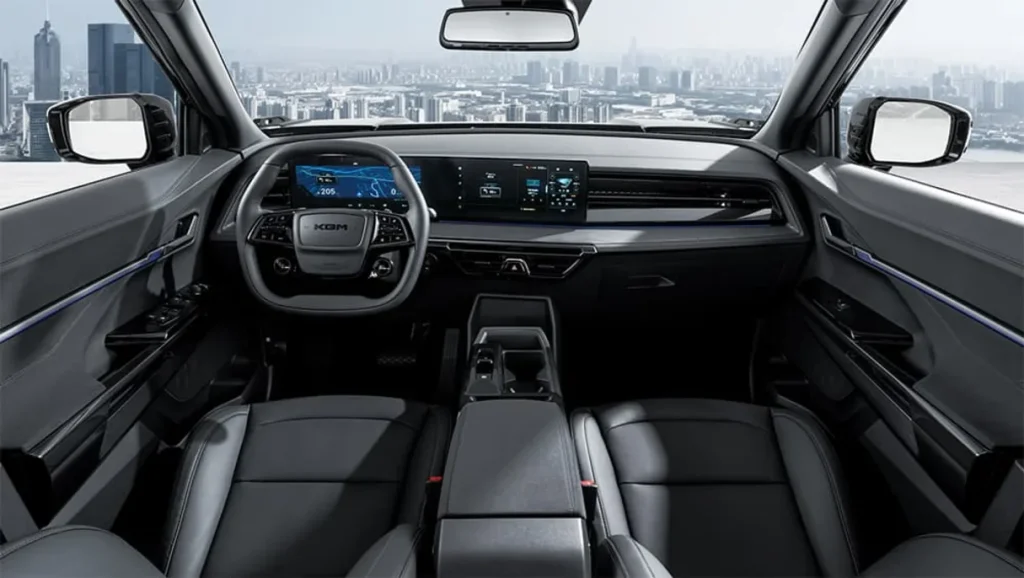
KG Mobility (formerly SsangYong) has begun to sharpen the contours of Australia’s next wave of electric utes with the Musso EV, an all‑electric version of its established Musso pick‑up. I drove a pre‑production dual‑motor example in the UK and assessed how the electric Musso might land here in Australia: its strengths, its compromises and what it means for tradies, fleet buyers and families considering a transition from diesel.
What it is and where it sits
The Musso EV aims to marry everyday usability with a well‑appointed cabin and modern electric powertrain. It arrives into a segment that has been cautious on electrification – the large ute market is still dominated by diesel workhorses such as the Toyota HiLux, Ford Ranger and Isuzu D‑Max – but this model shows how mainstream makers are starting to offer genuinely usable electric alternatives.
Key specifications and on-paper performance
- Powertrain: The pre‑production dual‑motor all‑wheel‑drive Musso EV I drove produced about 304 kW and 339 Nm in the configuration presented, delivering a 0-100 km/h time in the order of eight seconds. KGM plans to offer a single‑motor front‑wheel‑drive variant as well, which will be targeted at buyers who prioritise cost and efficiency over outright performance.
- Range and charging: KGM quotes up to about 380 km on the WLTP cycle for the dual‑motor car. Fast‑charging capability is specified up to 120 kW DC, with an 80 per cent charge achievable in just over 30 minutes under ideal conditions. Exact battery capacity figures and official ADR/NEDC/WLTP‑to‑real‑world conversions for Australia will be confirmed closer to local launch.
- Practical numbers: The Musso EV’s rear multi‑link suspension delivers a more car‑like ride than traditional leaf springs, but the trade‑off is payload – the pre‑production vehicle’s payload is rated at about 690 kg, noticeably lower than the roughly 1,000 kg (1 tonne) many tradies expect from this class. Braked towing capacity is listed at 1,800 kg, which also sits below typical diesel competitors.
Interior, equipment and refinement
Inside, the Musso EV feels a step up from many rivals in terms of perceived quality. Highlights observed in the pre‑production car include heated and ventilated Nappa leather front seats with power adjustment, heated rear seats, a heated steering wheel, dual‑zone climate control and Vehicle‑to‑Load (V2L) functionality – handy for powering tools on site or appliances while camping. The cabin is anchored by twin digital screens and contemporary copper‑tone trim that give the Musso a modern, near‑premium look.

Standard exterior kit includes full LED headlights, 17‑inch alloy wheels and side steps. The suite of driver assistance technologies is comprehensive, although some systems, notably lane‑keeping assist, can be overzealous in the pre‑production setup and may need refinement for local roads.
How it drives
On road, the Musso EV feels composed and quiet. The electric powertrain delivers smooth, linear acceleration with minimal driveline noise and only modest wind noise at motorway speeds. The multi‑link rear suspension noticeably improves ride comfort, soaking up imperfections better than the leaf springs that dominate many utility utes.
Real‑world range will be heavily influenced by Australian conditions. Hot summers, heavy loads, towing and rural distances can reduce WLTP‑stated range; prospective buyers should budget for lower figures when planning trips or workdays without frequent charging.
Practicality trade‑offs: payload, towing and market fit
The most consequential compromise for the Musso EV is payload. At about 690 kg, it undercuts the conventional expectation for this vehicle class in Australia. That will blunt its appeal to tradespeople and fleet operators who routinely carry heavy gear or require a full tonne of payload. Towing capacity of 1,800 kg is useful for many leisure applications – boat trailers, caravans and small plant trailers – but still falls short of some diesel rivals.
Where the Musso EV will impress is urban and mixed‑use ownership: families who appreciate a roomy, comfortable cabin; professionals who need occasional load carrying; and owner‑drivers who value lower running costs, quieter operation and V2L functionality for portable power. For fleet buyers whose duty cycles are chiefly urban and who value lower maintenance or emissions, the Musso could be compelling – provided payload requirements are modest.
Charging and ownership in the Australian context
Australia’s DC fast‑charging network has expanded rapidly, particularly along major corridors and in metropolitan centres, which supports the Musso EV’s 120 kW charging ceiling. That said, larger competitors and newer EVs are increasingly offering higher peak charging rates (150-350 kW), which shortens top‑up times on compatible chargers. Home charging will remain the primary means of daily replenishment for most owners, and V2L adds a layer of versatility for those who use power tools or camp frequently.
Local warranty, support and pricing
KGM has not yet released full Australian specification, warranty or pricing details for the Musso EV at the time of my drive. These elements will be critical to the vehicle’s competitiveness: a strong local warranty and a clear dealer service strategy will reassure buyers moving from established diesel brands. Pricing will determine whether the Musso EV is bought on aspiration, total cost of ownership or as a straightforward business decision.
Competition and outlook
Compared with other early electric utility offerings, the Musso EV presents a balanced proposition: it’s more comfortable and better equipped than many, but it also sacrifices payload. Its chief rivals in an Australian context are not only conventional diesel utes but any incoming electric utes that prioritise work capability. If KGM can refine load‑carrying ability or offer a variant with higher payload for trade customers, the Musso EV could broaden its appeal substantially.
What to watch before Australian launch
- Final ADR homologation and official Australian‑spec payload/towing numbers.
- Confirmed battery capacity and real‑world range figures under local test cycles.
- Australian pricing, standard equipment list and warranty terms.
- Any recalibration of driver aids and ride tuning for Australian road conditions.
- Availability of an entry single‑motor variant and whether it brings differential payload or efficiency advantages.
Conclusion
The KGM Musso EV represents a meaningful step toward mainstream electric utes in Australia. It combines a refined, well‑equipped cabin and a pleasant on‑road demeanour with a credible electric range and useful fast‑charging. However, its sub‑tonne payload and middling towing compared with diesel rivals will limit uptake among tradies and heavy‑use fleets. For urban families, professionals and light‑use fleet buyers seeking lower running costs and a modern cabin, the Musso EV could be a persuasive option – particularly if KGM confirms competitive pricing and robust aftersales support. As with all early electric utes, prospective buyers should wait for full Australian specifications and test drives on local roads before committing.
Frequently asked questions
Will the Musso EV arrive in Australia?
KGM has signalled plans to bring the Musso EV to major markets, and an Australian arrival is expected early in 2026. Exact timing will depend on homologation and supply chain schedules.
How far will the Musso EV travel on a single charge in real‑world use?
KGM quotes about 380 km WLTP for the dual‑motor model. Expect lower real‑world figures in Australian conditions, especially with hot weather, towing or heavy payloads.
Is the Musso EV suitable for tradespeople?
That depends on duty cycle. The Musso EV’s payload (around 690 kg in the pre‑production example) is below the roughly 1,000 kg many tradies expect, so it may not suit users who regularly carry heavy loads. It is better suited to light‑use trades, service vehicles, families and urban fleets.
How fast can it charge?
The Musso EV supports up to 120 kW DC fast‑charging, which can replenish about 80 per cent of charge in just over 30 minutes under ideal conditions. Home AC charging remains the most practical daily solution.
What are the Musso EV’s main advantages?
Comfortable ride, quiet electric powertrain, generous cabin equipment (including V2L), modern interior design and competitive electric range for everyday use.
About EV Evolution
EV Evolution is the leading online platform dedicated to Australian electric vehicle owners and enthusiasts. We foster a vibrant community, delivering essential EV news and insights, and enhancing user engagement through our innovative, AI-powered chatbot for dynamic discussions. Our mission is to empower Australian electric vehicle owners and enthusiasts by fostering a vibrant, AI-driven online community that connects, informs, and advances the nation’s electric vehicle landscape.




